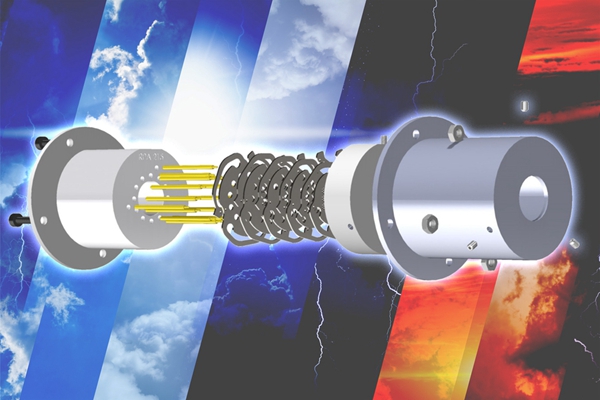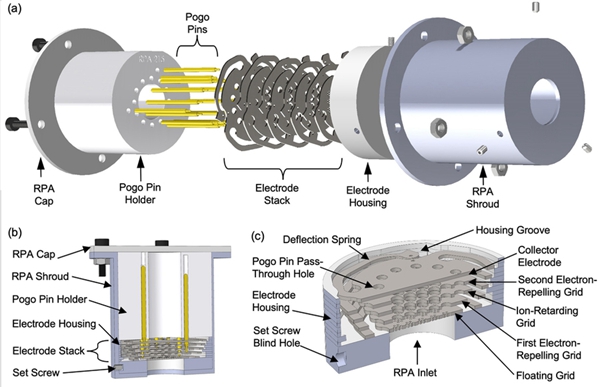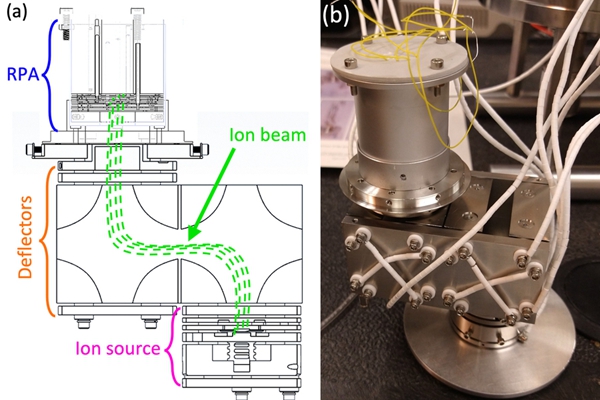31 July 2022 - MIT has built the first fully 3D-printedplasma sensors for an orbiting spacecraft, and they are extremely cost-effective. These plasma sensors, also known as delayed potential analysers (RPAs), are used by satellites to determine the chemical composition and ion energy distribution of the atmosphere.

△MIT experiments show 3D printing to be more cost effective than traditional process satellite sensors
3D printed and laser-cut plasma sensors have the same hardware performance, but the latter are manufactured in a clean room and therefore are expensive and require weeks of complex manufacturing. In contrast, 3D printed sensors can be produced in a matter of days for tens of dollars.
3D printing technology is ideally suited to the manufacture of satellite sensors due to its low cost and fast production rates. These cheap, low-powered and lightweight satellites are typically used for communications and environmental monitoring in the Earth's upper atmosphere.

△In the RPA, plasma passes through a series of electrically charged grids dotted with small holes. As the plasma passes through each grid, electrons and other particles are stripped away until only ions remain. This diagram shows how the grid is fitted inside the RPA shell
The researchers, developed the RPA using a glass-ceramic material that is more durable than traditional sensor materials such as silicon and thin-film coatings. By using the glass-ceramic in a manufacturing process developed for 3D printing plastics, they were able to create sensors with complex shapes that can withstand the wide range of temperature fluctuations encountered by spacecraft in low Earth orbit.
3D printing technology, could make a huge difference to the future of space hardware," said Luis Fernando Velásquez-García, lead scientist at MIT's Microsystems Technology Laboratory (MTL) and senior author of the plasma sensor paper. Some people think that when you 3D print something, you have to sacrifice a certain amount of performance. But, as we have proved, this is not always the case. Sometimes, nothing is different."
A multi-purpose sensor
The RPA was first used in space missions in 1959. These sensors detect the energy of ions or charged particles floating in plasma, a superheated mixture of molecules present in the Earth's upper atmosphere. On orbiting spacecraft like CubeSats, these versatile instruments measure energy and perform chemical analyses that can help scientists predict the weather or monitor climate change.
These sensors contain a series of electrically charged webs dotted with small holes. As the plasma passes through these holes, electrons and other particles are stripped away until only ions remain. These ions produce an electric current, which is measured and analysed by the sensor.
The key to the success of the RPA is the structure of the shell that aligns the grid. It had to be electrically insulated and also able to withstand sudden and violent fluctuations in temperature. The researchers used a printable glass-ceramic material that displays these properties, known as Vitrolite.
Vitrolite set the precedent in the early 20th century and is often used in coloured tiles, which have become a common feature in the landscape of Art Deco buildings.
This durable material can also withstand temperatures of up to 800 degrees Celsius without decomposing, whereas the polymer used for the semiconductor RPA begins to melt at 400 degrees Celsius.
Velásquez-García: "When you make such sensors in a clean room, you are not free to design their structure the way you want, but 3D printing breaks through this limitation."

△The figure shows an experiment in which the researchers set up their RPA to characterise it as an ion energy distribution sensor
Rethinking manufacturing
The process of 3D printing ceramics typically involves ceramic powders that are melted into shape with a laser, but this process often leaves the material rough and creates weak spots due to the high heat of the laser.
Instead, researchers at MIT have used vat polymerisation, a process introduced decades ago for additive manufacturing of polymers or resins. In vat polymerisation, three-dimensional structures are built up one layer at a time by repeatedly dipping them into a vat of liquid material, in this case Vitrolite. After each layer has been added, UV light is used to cure the material and the platform is then dipped into the vat again. Each layer is only 100 microns thick (about the diameter of a human hair), enabling the creation of smooth, non-porous, complex ceramic shapes.
In digital fabrication, the objects described in the design documents can be very complex. This precision allowed the researchers to create laser-cut lattices with unique shapes that lined up perfectly when setting up the holes within the RPA shell. This allows more ions to pass through, leading to higher resolution measurements.
As the sensors are cheap to produce and can be manufactured quickly, the team produced four unique design prototypes.
One of the designs is particularly effective at capturing and measuring a wide range of plasmas, like those encountered by satellites in orbit, while the other is ideally suited to sensing extremely dense and cold plasmas that can typically only be measured with ultra-precise semiconductor devices.
This high precision could enable 3D printed sensors with applications in fusion energy research or supersonic flight, Velásquez-García added, adding that access to rapid prototyping capabilities could even spur more innovation in satellite and spacecraft design.
"If you want to innovate, you need to be able to fail and take risks. 3D printing technology is an indispensable way to make space hardware. I can make space hardware and if it fails, it doesn't matter because I can make a new version very quickly and cheaply and really iterate on the design. It's an ideal design model for researchers," he says.
Although Velásquez-García is pleased with the sensors, in the future he hopes to continue improving the process. Reducing the thickness of the layers or the pixel size in glass-ceramic vat polymerisation could create more accurate and complex hardware. In addition, fully 3D printed sensors would make them compatible with space manufacturing. He also hopes to explore the use of artificial intelligence to optimise the design of sensors for specific use cases, for example by significantly reducing their mass while ensuring they remain structurally sound.





